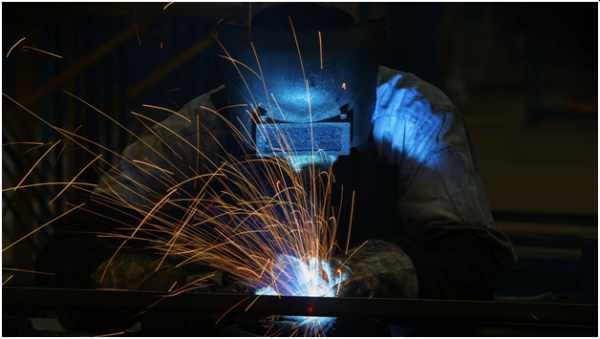Are you familiar with the process of metal fabrication? It involves any type of molding, cutting, folding, forging, stamping, and welding of this material so as to create a product. Besides aluminum, copper, iron, nickel, gold, silver, titanium, and brass are commonly used in the procedure.

Machine shops employ various fabrication methods for manufacturing metal parts required by clients for an application in multiple industries.
These are the most common processes performed in machine shops.
Casting
The casting process is commonly used in machine shops, referring to the action of pouring molten metal into a mold for the purpose of forming a particular shape when the material hardens. Casting can be of multiple types depending on the method of material fabrication. Read more about the history and different types of casting.
For example, die-casting involves pouring molten metal into a die, whereas permanent mold casting involves using a mold for shaping the liquid material into the desired shape. The latter is believed to produce stronger components but these are rather demanding to remove from the mold. Therefore, some machine shops use semi-permanent molds, which are more expandable and allow easier removal of the final product.
Casting is considered perfect when it comes to the mass production of such0 components, as a single mold is used in the manufacturing of identical parts. This process is mainly employed for the formation of metal parts used in the mining, healthcare, automotive, agriculture, culinary, and military industry.
Cutting
Another common process used by machine shops in the manufacturing of metal components is cutting. As the name suggests, the procedure involves cutting the material into smaller pieces in accordance with the dimensions of the product. It’s either the initial step of manufacturing such parts or the only method used in their creation.
In the past, sawing was the most popular cutting method, nowadays replaced by high-tech solutions. In recent times, machine shops have started using power scissors, waterjet, and laser cutting for providing better precision. CNC cutters have gradually replaced the use of manual tools due to the lower risk of mistakes while cutting materials.

Forging
Forging is a well-known method of shaping metals with the assistance of compressive forces as long as the material is heated to a point of malleability. Besides standard forging, machine shops also use warm and hot forging. The former is performed once the material is heated to a point it exceeds room temperature but doesn’t reach recrystallization temperature. Conversely, the latter is performed when the material reaches the temperature of recrystallization.
In addition, forging is used in the production of metal parts for the medical, aerospace, power generation, and automotive industries. These components can be applied in the production of valves, sockets, hooks, shafts, gears, missiles, etc.
Folding
Folding, also known as press braking, refers to the process of bending metals at a particular angle by using a brake press. Machine shop workers use this fabrication method for folding metal sheets. The materials are either bent manually with a hammer or by using a folder, a special machine designed for the same purpose.
Additionally, folding is considered efficient in the creation of components used in industrial manufacturing, electronics manufacturing, the construction, and architecture industries. Such parts are applied in the production of safety features, electronics, and housing products.
Stamping
Stamping is yet another sought-after fabrication process, performed with a stamping press. This tool applies enough pressure for the metal panel to acquire different forms, images, and letters. The majority of manufacturers of metal parts, such as UHI Group, use stamping for the creation of floor pans, hoods, body side, and car doors. The stamping presses designed for this process are either mechanical or hydraulic.
With the help of stamping, machine shop workers mold metal sheets into a variety of forms, later used in the production of different goods, even coins. This process is most beneficial in the manufacturing of hardware, appliances, and fastenings. Consequently, it plays a major role in the creation of electronics, power tools, engines, ammunition, lighting, and blanking.
Machining
Machine shops use machining for the removal of unnecessary material during the process of shaping metal. Several machines can be employed for the performance of this process, those being the drilling, milling, and turning machine. For example, the drilling machine makes a hole in the material with a tool that rotates amazingly fast in an effort to cut a hole.
Milling machines also use a cutting tool that rotates while removing material from the panel. Machine shop workers move the tool across the surface waiting for the material to be slowly removed. Depending on the desired outcome, workers employ angular, plain, climb, or face milling in the production of final products. Ultimately, turning machines rotate the material with the assistance of a lathe. In the meantime, metal is cut in the shape of a cylinder by a tool that performs the cutting process in a linear direction. By changing the angle of the tool, workers are capable of cutting various shapes.
Welding
Welding is a well-known process in the fabrication of metal parts, using pressure and heat to combine at least two types of metal regardless of their size and shape. Machine shop workers are proficient at several kinds of welding, such as Arc welding, MIG welding, TIG welding, and FCAW (Flux Cored Arc Welding).
Arc welding is characteristic for the formation of an electronic arc when the electrode stick touches the material, hence commencing the welding procedure. In contrast, MIG welding is faster because of the use of shielding gas. This gas is introduced for the purpose of protecting the material against environmental elements. TIG welding is ideal for welding heavier types of metals, hence requiring a skilled worker for performing the procedure.
The bottom line
Each one of the above-mentioned processes is beneficial in its own way.
Machine shop workers know which one to choose in order to ensure clients are satisfied with the results!
